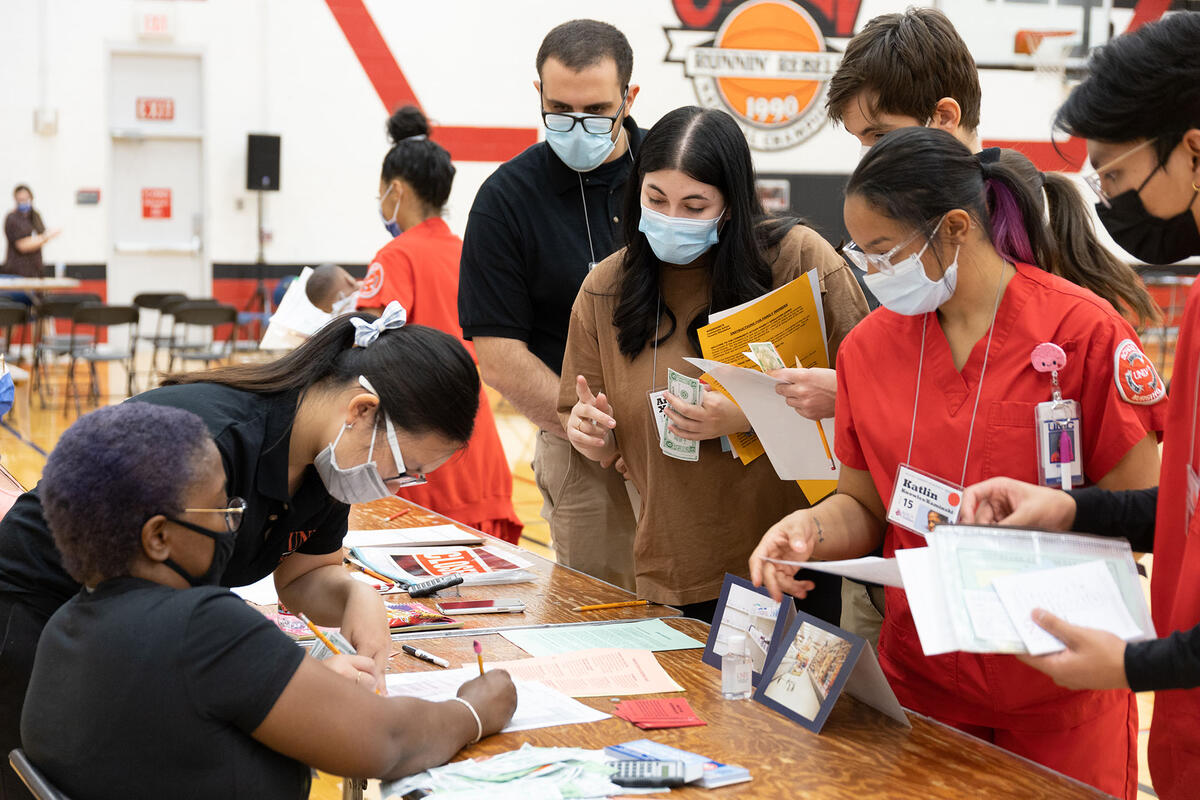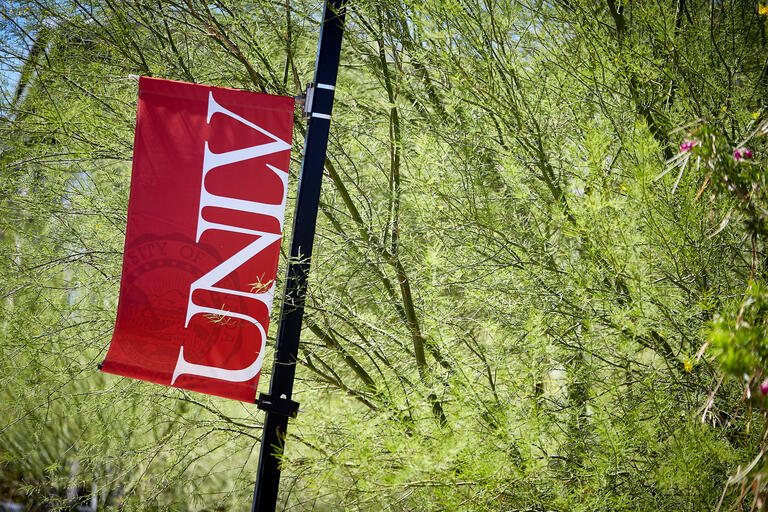In 15 minutes, UNLV Nursing student Dilon Petersen went from being homeless to finding housing, visiting social services, and pawning items at the pawn shop, all while taking care of his 1-year-old child as a single mother.
These 15 minutes represented one full week in UNLV’s Poverty Simulation, an interprofessional education exercise involving 80 students from Nursing, Medicine, and Dental Medicine. Back after a one-year hiatus, the simulation is an empathy-building tool that helps students like Petersen understand the challenges of poverty and both the resources and barriers connected with community services.
Real-Life Circumstances
The School of Nursing has hosted the poverty simulation since 2009 (with Dental Medicine joining in 2017 and the Kirk Kerkorian School Medicine in 2019). Minnie Wood, Nursing’s director of clinical and community partnerships, says the immersive experience helps contextualize healthcare services in a simulated month.
While the situations could apply to pandemic times, Wood says the simulation draws upon national statistics and broad circumstances.
“It’s meant to replicate actual conditions that exist in our society,” she says.
Students from each health school are assigned randomly into a family based on premade kits, complete with name badges and baggies that share their specific roles. The students play struggling families above, near, or below the poverty line. They perform important activities, like going to work or school, in four 15-minute increments. These conditions are heightened with paying rent, medical bills, and other living expenses. Other participants represent community agencies like banks, grocery stores, childcare and police services.
Not every routine is the same. While one person goes to work, another looks for employment. There are parents who drop off kids at daycare, while other parents figure out what to do with their children because they can’t afford it, all while the clock is ticking.
“You will literally see students searching for their home, realize they don't have one and then have to figure [out] where should [they] go.” says Jennifer Young, director of community engagement for Kerkorian School of Medicine. “They go to the homeless shelter and then navigate through social services, caseworkers, and the realtor.”
First-year dental student Alicia Carlos says, “This was my first poverty simulation, and it was maximum stress, but it helped me realize just how many barriers people living near the poverty level face each day. One of the bigger barriers was trying to get someplace — it was never easy because there were so many factors to consider.”
When Life Goes Off Script
Scripts guide the simulation with rules for every role. Faculty and staff keep the scripts from the students until the day of the simulation. “We don't want them planning,” Wood says. “We just want them to come in and experience it.”
Within general parameters, there is room for improvisation. Volunteers can decide how to engage students, like making it more difficult for them. “We’re not an agency, we’re a business,” says the pawn shop owner to a student trying to pawn her antique television set.
A realtor, for example, “forgets” to give a family a receipt for their rent one week. This angers the renters when they face eviction without proof of paying their rent. Wood explains, “It's an interesting learning experience because students go, ‘That's bull, I paid my rent,’ and we tell them, ‘This happens all over the country with predatory landlords’ — that people don't have that right to housing and people pay in cash. If they lose a receipt, they're screwed.”
Simulation facilitators will intervene with reminders or random events (luck-of-the-draw cards) to add more obstacles, like a surprise emergency surgery. Other times, faculty remind students they didn’t buy groceries for a whole week, or they accidentally left their children at home. Students have to judge which tasks to focus on and which to neglect. “When you're in that situation,” Wood says, “where does my medical, health, and dental care fall on my list of priorities? Usually, it's [lower] because you're just trying to survive.”
Not for Fun
The simulation’s performances, scripts, and ad-libbing give the impression the exercise is a giant skit, but faculty and staff stress this is not a game. “Even though this is a simulation, these are actual people's lives,” Young emphasizes. “Poverty is simply a set of circumstances. I think particularly for this state and the city, we've seen ups and downs, and I don't think anyone is immune.”
From eviction to jail to juvenile hall, there are consequences in the simulation like in real life. There are also instances where students could be reminded of their own childhood in comparable conditions. Nursing student Zaria Nobles, who grew up in a similar situation, noted her personal experience helped her maneuver around the different simulation services, but she admits it was still eye-opening.
“It made me see back then this is what I had to do,” Nobles says. “Now I realize we overcame that, and I can do what I need.”
Students who are anxious about the simulation can request to be moved to other community roles.
Individual vs. Societal Causes
Faculty, staff, and students debrief after the simulation is over. There are more apparent takeaways about how much work goes into surviving when you have limited resources, but students also saw firsthand the trouble of not having reliable transportation; waiting for medical appointments; extensive paperwork; and how to balance their hierarchy of needs.
Young hopes to raise more awareness about the idea that it’s not always a person’s fault for living in poverty; there are systemic factors that play a role.
“As a society, we have a thought process of, ‘Pull yourself up by your bootstraps,’ that we all have control of our destiny, and if you are not prospering, it is due to you lacking in some way,” she explains. “I think in the last year-and-a-half, with social unrest, with looking at equity health-wise, race-wise, wealth-wise, that our society is getting a better understanding about the structural differences that contribute to why certain groups and demographics, in general, can move forward or be financially successful.”



